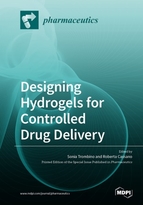Designing Hydrogels for Controlled Drug Delivery
A special issue of Pharmaceutics (ISSN 1999-4923).
Deadline for manuscript submissions: closed (30 September 2019) | Viewed by 56895
Special Issue Editors
Interests: drug delivery systems (DDS); biomaterials; multifunctional carriers; micro- and nano-particles; pro-drugs
Special Issues, Collections and Topics in MDPI journals
Interests: drug delivery systems (DDS); biomaterials; multifunctional carriers; micro-and nano-particles; pro-drugs
Special Issues, Collections and Topics in MDPI journals
Special Issue Information
Dear Colleagues,
Hydrogels have received growing attention in recent years as materials for drug delivery systems (DDS), because they are biocompatible and nontoxic. They consist of three-dimensional, hydrophilic, polymeric networks capable of imbibing large quantities of water or biological fluids, due to the presence of hydrophilic groups, and releasing the drugs entrapped in them through slow diffusion. According to their features, they can be natural or synthetic and classified as neutral or ionic hydrogels, while the network can be made up of linear homopolymers, linear copolymers, and block or graft copolymers. Hydrogels can provide spatial and temporal control over the release of various therapeutic agents, including both small molecules and macromolecular drugs. They possess modulable physical properties and the capability to protect labile drugs from degradation controlling their release. This Special Issue welcomes all topics regarding recent studies on the design, preparation, and performance evaluation of hydrogels for controlled drug delivery.
Prof. Sonia Trombino
Dr. Roberta Cassano
Guest Editors
Manuscript Submission Information
Manuscripts should be submitted online at www.mdpi.com by registering and logging in to this website. Once you are registered, click here to go to the submission form. Manuscripts can be submitted until the deadline. All submissions that pass pre-check are peer-reviewed. Accepted papers will be published continuously in the journal (as soon as accepted) and will be listed together on the special issue website. Research articles, review articles as well as short communications are invited. For planned papers, a title and short abstract (about 100 words) can be sent to the Editorial Office for announcement on this website.
Submitted manuscripts should not have been published previously, nor be under consideration for publication elsewhere (except conference proceedings papers). All manuscripts are thoroughly refereed through a single-blind peer-review process. A guide for authors and other relevant information for submission of manuscripts is available on the Instructions for Authors page. Pharmaceutics is an international peer-reviewed open access monthly journal published by MDPI.
Please visit the Instructions for Authors page before submitting a manuscript. The Article Processing Charge (APC) for publication in this open access journal is 2900 CHF (Swiss Francs). Submitted papers should be well formatted and use good English. Authors may use MDPI's English editing service prior to publication or during author revisions.
Keywords
- Hydrogels
- Classification
- Natural materials
- Synthetic materials
- Methods of fabrication
- Drug delivery
- Pharmaceutical applications








